The world of pet nutrition is vast and often confusing, with many pet owners seeking the best diets for their furry companions. As more pet food brands introduce grain-free options, a common question arises: can cats eat grain-free dog food? This inquiry is rooted in the understanding that cats and dogs have different nutritional requirements due to their distinct evolutionary paths, metabolisms, and dietary needs. This essay aims to explore the implications of feeding cats grain-free dog food, examining the nutritional differences between cat and dog food, the potential risks involved, and the best practices for ensuring a balanced diet for felines.
Understanding Feline Nutrition
The Obligate Carnivore
Cats are classified as obligate carnivores, meaning that their diet must primarily consist of meat. Unlike dogs, which are omnivores and can thrive on a more varied diet, cats have evolved to require certain nutrients that are predominantly found in animal tissues. These include:
Taurine: An essential amino acid that cats cannot synthesize in sufficient quantities. It is crucial for heart function, vision, and reproductive health.
Arachidonic Acid: A fatty acid that cats cannot produce and must obtain from animal fats.
Vitamin A: Cats cannot convert beta-carotene from plants into vitamin A and must consume it directly from animal sources.
Nutritional Requirements
A cat’s diet should be high in protein (around 30-40% of their caloric intake), moderate in fat (around 20-30%), and low in carbohydrates (less than 10%). This macronutrient balance supports their energy needs and overall health. In contrast, dog food may contain higher levels of carbohydrates and lower protein content, reflecting the dietary flexibility of dogs.
The Composition of Dog Food
Grain-Free Dog Food
Grain-free dog food has gained popularity among pet owners who believe that grains may cause allergies or digestive issues in their pets. These formulations typically substitute grains with alternative carbohydrates such as peas, lentils, potatoes, and tapioca. While these ingredients can provide energy, they do not necessarily meet the specific nutritional needs of cats.
Nutritional Differences
Protein Content: Most grain-free dog foods contain less protein than cat food. While some brands may market their products as high-protein, the protein sources may not be as bioavailable or complete for cats.
Essential Nutrients: Grain-free dog food often lacks key nutrients that are critical for feline health. For example, it may not contain adequate levels of taurine, arachidonic acid, or vitamin A, leading to potential deficiencies.
Carbohydrate Sources: The alternative carbohydrate sources used in grain-free dog food can be problematic for cats. Cats have a limited ability to digest carbohydrates, and high-carb diets can lead to obesity, diabetes, and other health issues.
Can Cats Eat Grain-Free Dog Food
Short-Term Consumption
In an emergency or if a cat accidentally consumes a small amount of grain-free dog food, it is unlikely to cause immediate harm. However, this should not be a regular practice. The nutritional deficiencies in dog food can lead to long-term health issues if it becomes a staple in a cat’s diet.
Long-Term Health Risks
Feeding cats grain-free dog food on a regular basis can result in several health problems, including:
Nutritional Deficiencies: Prolonged consumption can lead to deficiencies in essential nutrients, particularly taurine, which can cause serious health issues like dilated cardiomyopathy (DCM), a heart condition.
Obesity and Diabetes: The carbohydrate content in dog food, even if grain-free, can lead to weight gain and increase the risk of diabetes in cats, particularly if they are not as active.
Digestive Issues: Cats may experience gastrointestinal upset, including diarrhea or vomiting, when consuming dog food regularly.
Best Practices for Cat Nutrition
Choosing the Right Food
When selecting food for a cat, it is crucial to choose a product specifically formulated for felines. Look for the following:
High Protein Content: Ensure that the food contains a high percentage of animal-based protein.
Complete and Balanced: Check that the food meets the standards set by the Association of American Feed Control Officials (AAFCO) for cat food.
Quality Ingredients: Opt for foods that list real meat as the first ingredient and avoid those with excessive fillers or artificial additives.
Transitioning Diets
If you need to change your cat’s diet, do so gradually over a week or two to avoid digestive upset. Mix increasing amounts of the new food with the old food until the transition is complete.
Regular Veterinary Check-Ups
Regular check-ups with a veterinarian can help monitor your cat’s health and nutritional status. Your vet can provide personalized dietary recommendations based on your cat’s age, weight, health status, and lifestyle.
Conclusion
In conclusion, while cats may occasionally nibble on grain-free dog food without immediate consequences, it is not a suitable or safe long-term dietary choice. Cats require a diet specifically formulated to meet their unique nutritional needs, and grain-free dog food typically lacks the essential nutrients necessary for their health. Pet owners should prioritize species-appropriate diets and consult with veterinarians for guidance on maintaining optimal feline nutrition. By understanding the differences between cat and dog food and adhering to best practices, cat owners can ensure their pets lead healthy, happy lives.
Related topic:



























